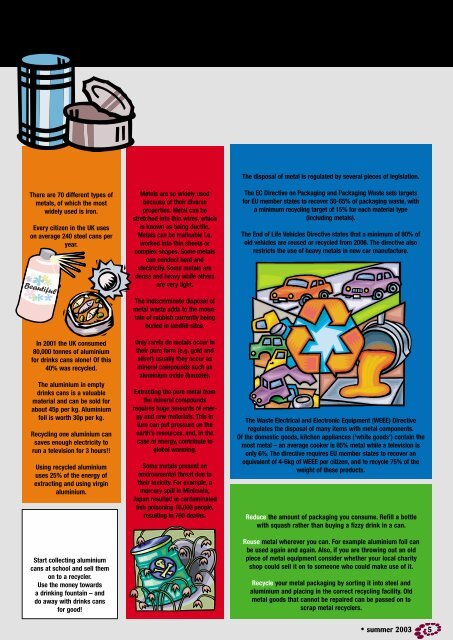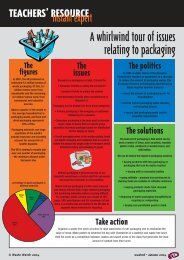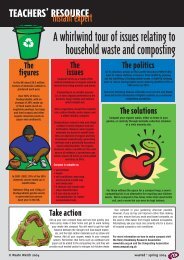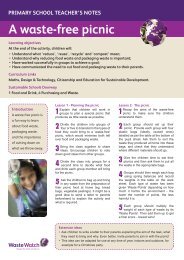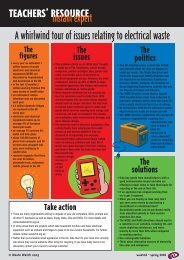Metals - Recyclezone
Metals - Recyclezone
Metals - Recyclezone
Create successful ePaper yourself
Turn your PDF publications into a flip-book with our unique Google optimized e-Paper software.
TEACHERS’ RESOURCE<br />
instant expert<br />
A whirlwind tour of issues relating<br />
The<br />
figures<br />
There are 70 different types of<br />
metals, of which the most<br />
widely used is iron.<br />
Every citizen in the UK uses<br />
on average 240 steel cans per<br />
year.<br />
The<br />
issues<br />
<strong>Metals</strong> are so widely used<br />
because of their diverse<br />
properties. Metal can be<br />
stretched into thin wires, which<br />
is known as being ductile.<br />
<strong>Metals</strong> can be malleable i.e.<br />
worked into thin sheets or<br />
complex shapes. Some metals<br />
can conduct heat and<br />
electricity. Some metals are<br />
dense and heavy while others<br />
are very light.<br />
to metal waste and recycling<br />
The politics<br />
The disposal of metal is regulated by several pieces of legislation.<br />
The EC Directive on Packaging and Packaging Waste sets targets<br />
for EU member states to recover 50-65% of packaging waste, with<br />
a minimum recycling target of 15% for each material type<br />
(including metals).<br />
The End of Life Vehicles Directive states that a minimum of 80% of<br />
old vehicles are reused or recycled from 2006. The directive also<br />
restricts the use of heavy metals in new car manufacture.<br />
In 2001 the UK consumed<br />
80,000 tonnes of aluminium<br />
for drinks cans alone! Of this<br />
40% was recycled.<br />
The aluminium in empty<br />
drinks cans is a valuable<br />
material and can be sold for<br />
about 45p per kg. Aluminium<br />
foil is worth 30p per kg.<br />
Recycling one aluminium can<br />
saves enough electricity to<br />
run a television for 3 hours!!<br />
Using recycled aluminium<br />
uses 25% of the energy of<br />
extracting and using virgin<br />
aluminium.<br />
Take<br />
action<br />
Start collecting aluminium<br />
cans at school and sell them<br />
on to a recycler.<br />
Use the money towards<br />
a drinking fountain – and<br />
do away with drinks cans<br />
for good!<br />
The indiscriminate disposal of<br />
metal waste adds to the mountain<br />
of rubbish currently being<br />
buried in landfill sites.<br />
Only rarely do metals occur in<br />
their pure form (e.g. gold and<br />
silver) usually they occur as<br />
mineral compounds such as<br />
aluminium oxide (bauxite).<br />
Extracting the pure metal from<br />
the mineral compounds<br />
requires huge amounts of energy<br />
and raw materials. This in<br />
turn can put pressure on the<br />
earth’s resources, and, in the<br />
case of energy, contribute to<br />
global warming.<br />
Some metals present an<br />
environmental threat due to<br />
their toxicity. For example, a<br />
mercury spill in Minimata,<br />
Japan resulted in contaminated<br />
fish poisoning 18,000 people,<br />
resulting in 700 deaths.<br />
The Waste Electrical and Electronic Equipment (WEEE) Directive<br />
regulates the disposal of many items with metal components.<br />
Of the domestic goods, kitchen appliances (‘white goods’) contain the<br />
most metal – an average cooker is 85% metal while a television is<br />
only 6%. The directive requires EU member states to recover an<br />
equivalent of 4-6kg of WEEE per citizen, and to recycle 75% of the<br />
weight of these products.<br />
The solutions<br />
Reduce the amount of packaging you consume. Refill a bottle<br />
with squash rather than buying a fizzy drink in a can.<br />
Reuse metal wherever you can. For example aluminium foil can<br />
be used again and again. Also, if you are throwing out an old<br />
piece of metal equipment consider whether your local charity<br />
shop could sell it on to someone who could make use of it.<br />
Recycle your metal packaging by sorting it into steel and<br />
aluminium and placing in the correct recycling facility. Old<br />
metal goods that cannot be repaired can be passed on to<br />
scrap metal recyclers.<br />
wasted • summer 2003 5
TEACHERS’ RESOURCE<br />
primary years<br />
Investigating metals<br />
Aim<br />
These activities focus on two commonly encountered metals: steel and<br />
aluminium. The aim is to demonstrate why metal is such a useful material.<br />
You will need<br />
■ 2 different types of foil and cans. Make sure there are no sharp edges on<br />
the cans. Have other types of plastic, paper and glass packaging to<br />
compare and contrast with the metal items.<br />
■ Some magnets<br />
■ A scale or balance<br />
Activity 1<br />
■ Sort the items made of metal from other items.<br />
Discuss how to do this, considering whether a<br />
material is hard or soft, transparent or opaque,<br />
light or heavy.<br />
■ Identify whether a can is made of steel or<br />
aluminium by looking for the recycling symbols shown<br />
opposite and use these to sort the cans.<br />
■ Examine the cans in more detail. If a can has a round and shiny bottom<br />
then it is aluminium. If a can attracts a magnet then it is steel.<br />
■ Use the ‘scrunch test’ to identify aluminium foil. If a piece of foil is<br />
scrunched up, the aluminium foil will stay that way once released, a<br />
piece of plastic foil will try and spring back to its original shape.<br />
Activity 2<br />
<strong>Metals</strong> are useful because they are strong and good conductors of heat and<br />
electricity. Aluminium has specific properties that can be investigated in<br />
different ways.<br />
Lightness – aluminium has a low density compared to other metals, for<br />
example it weighs about one third of iron. Use scales or simple balances to<br />
compare the weights of steel and aluminium drinks cans.<br />
Easily moulded into complex shapes – aluminium is a ductile and<br />
malleable metal. Get an adult to cut open an aluminium can and a steel<br />
can. Make sure that all sharp edges are properly covered with heavy tape.<br />
Compare the malleability of each by bending and squashing the material.<br />
Resists corrosion – aluminium resists corrosion due to a thin protective<br />
film of aluminium oxide that forms on its surface when it is in contact with<br />
the atmosphere. Bury an aluminium can, a steel can, a paper bag, and an<br />
apple core outside (remember to mark where you left them!) and compare<br />
the corrosion on each after one month. This illustrates what happens if a<br />
can is disposed of incorrectly, and will not break down naturally. Remember<br />
to wear strong rubber gloves when carrying out this experiment.<br />
Discuss why these properties mean metal is used for so many different things.<br />
Activity 3<br />
Discuss the journey of an aluminium can and follow<br />
it on a map. The rock containing aluminium is<br />
mined, for example in Australia, Africa or S.<br />
America. From Australia it is then refined and<br />
transported to Scandinavia. Here the metal is<br />
extracted, using lots of electricity. The metal is<br />
transported to Germany and rolled into sheets. Then it<br />
is taken to a factory in England and rolled into thinner<br />
sheets. Then it is taken to another factory to be made into cans. Then it is<br />
filled with drink and finally taken to a shop.<br />
6 summer 2003 • wasted<br />
Metal recycling<br />
Aluminium<br />
Aluminium packaging often bears this symbol. If it doesn’t<br />
then aluminium cans can often be identified by their<br />
rounded and shiny bottom while aluminium foil will<br />
remain compacted if it is scrunched up. Aluminium is not<br />
magnetic, is very light, and cans are quite easily crushed.<br />
Typically used for fizzy drinks and aerosols (check with<br />
your recycling facility before putting these in).<br />
Steel<br />
Steel cans will often bear this symbol.<br />
Steel cans are harder and heavier than<br />
aluminium ones. The so called ‘tin can’<br />
refers to the extremely thin layer of tin<br />
that the can is coated in to prevent<br />
corrosion. Steel cans are magnetic.<br />
Reusing metals<br />
Here are some great ideas for reusing metals.<br />
■ Make a plant pot from an old tin can. Soak the can in<br />
water for a few hours and remove the paper label<br />
(remembering to recycle it of course!). Decorate the tin<br />
in any way you like. Get your teacher to punch some<br />
holes in the bottom of the tin so water can drain out.<br />
Add soil and a plant!<br />
■ Use old CDs (especially those unwanted internet CDs)<br />
to make drinks coasters. The outer coating of a CD is<br />
plastic, but inside is metal<br />
■ Collect some large tin cans from your school kitchen<br />
and make stilts. Punch two holes on either side near<br />
the bottom of the can and thread through some strong<br />
twine and tie the ends together. Turn the can over and<br />
you’ve got stilts!<br />
source: Alupro
Aluminium - production and recycling<br />
TEACHERS’ RESOURCE<br />
secondary years<br />
Aluminium occurs naturally in mineral compounds such as bauxite. It<br />
takes a lot of time and energy to produce the pure aluminium used in<br />
products such as drinks cans or aeroplane parts. Overall, to make one<br />
tonne of new aluminium requires about 4 tonnes of bauxite and other<br />
materials, along with 17,000 kWh of electricity. There are three main<br />
stages in the process.<br />
Mining<br />
The rock containing aluminium, bauxite, is mined<br />
using an opencast strip method, mainly in Australia,<br />
West Africa and the West Indies. Although the topsoil<br />
is stripped and then replaced there is considerable damage caused to<br />
the local environment by the large open mines.<br />
Producing one kilogram of new aluminium<br />
Explosives<br />
500 kwh<br />
Mining<br />
Approx. 3<br />
tonnes bauxite<br />
‘overburden’<br />
i.e. unwanted<br />
rock<br />
180 kg<br />
caustic soda<br />
2500kwh<br />
Refining<br />
Approx.<br />
2 tonnes of<br />
impurities<br />
0.5 tonnes<br />
carbon<br />
14,000 kwh<br />
Smelting<br />
100 kg<br />
of residues<br />
1 kg<br />
aluminum<br />
Refining<br />
The Bayer process is used to produce alumina (Al2O3) from bauxite.<br />
First, the bauxite is washed, ground and dissolved in caustic soda (sodium<br />
hydroxide) at high pressure (30 atmospheres) and at high temperature<br />
(240°C). The undissolved impurities are filtered out. The solution<br />
is pumped into a tank (the precipitator). Fine particles of alumina are<br />
added causing pure alumina to form and settle out as the liquor cools.<br />
Design a can crusher<br />
Recycling aluminium is good for the environment and can be a useful way<br />
to raise funds. By crushing and reducing the volume of an empty can,<br />
schools can lower storage space and collection costs. D & T lessons<br />
are the perfect vehicle for pupils to design and produce their own can<br />
crushers to be used in schools. Can crushers need to be:<br />
• easy to use • easy to clean • tough and robust<br />
• easy to empty • safe<br />
By carrying out this task pupils will achieve many of the requirements set<br />
out in the Programme of Study at Key Stage 3. These include “respond to<br />
design briefs and produce their own design specifications for products”<br />
(1b) and “test how well their products work, then evaluate them” (3b).<br />
Smelting<br />
The alumina is dissolved in cryolite (sodium aluminium fluoride), to<br />
lower its melting point, and held in a large carbon-lined container at<br />
about 980°C. Positively charged electric rods of carbon (anodes) are<br />
dipped into the molten alumina. An electric current is then passed<br />
through the alumina at low voltage (about 5 volts) but at about 150,000<br />
amps. The molten aluminium collects at the bottom of the tank and can<br />
be siphoned off. As this process needs a lot of electricity it normally<br />
takes place in countries that have access to cheap, normally hydro,<br />
electricity. So for example the aluminium used in the UK is usually<br />
smelted in Scandinavia.<br />
Recycling Aluminium<br />
Recycling aluminium requires less than 25% of the energy needed to<br />
produce the metal in the first place. There is also no loss of quality as<br />
aluminium can effectively be recycled continuously. However, about<br />
15% of the material is lost with every recycle. All of the stages in the<br />
recycling process can take place in the UK.<br />
Producing one kilogram of<br />
recycled aluminium<br />
Recycle, collect and sort material. The sorting usually takes place in a Materials<br />
Recycling Facility which separates the aluminium packaging from other materials.<br />
800 kWh<br />
Photos courtesy of Alupro<br />
For cans the aluminium is shredded, de-coated (by air<br />
at 500°C) and re-melted. It is then cast back into aluminium<br />
blocks (called ingots). Aluminium foil is simply<br />
remelted.<br />
200 kg of “dross”, i.e.<br />
unwanted residues<br />
1 tonne of aluminium, ready to be made into cans,<br />
foil, cars or even aeroplanes! FACT: SAS Airlines<br />
collect enough aluminium drinks cans off flights in<br />
a year to make 75% of the metal<br />
needed to build a new McDonnell<br />
Douglas MD-90 airliner.<br />
wasted • summer 2003 7
TEACHERS’ RESOURCE<br />
useful websites<br />
All the information you need is out there on the<br />
internet – somewhere! We tell you where to look.<br />
Ollie Recycles<br />
www.ollierecycles.com/uk<br />
A child friendly website full of games,<br />
puzzles and information. Ollie and his<br />
friends show you around and teach<br />
you more about the 3Rs – Reduce,<br />
Reuse and Recycle. Click on ‘Recycle’<br />
in the ‘Explore’ section to find facts<br />
and figures about steel and<br />
aluminium, including what we use<br />
them for and how they can be<br />
recycled. There are also quizzes to<br />
test your knowledge and a curriculum<br />
checklist for teachers.<br />
the French army There is a children’s<br />
zone with games and information and<br />
you can submit questions to find out<br />
more about steel can recycling.<br />
Waste Online<br />
www.wasteonline.org.uk<br />
The place to go for information sheets<br />
on the recycling of aluminium, steel<br />
packaging and lots more. Good<br />
background information for teachers<br />
and also useful for research work by<br />
secondary students.<br />
Junk to Gems<br />
www.junktogems.org.nz<br />
An inspirational and attractive site<br />
showing art made from junk by both<br />
children from New Zealand and a<br />
selection of British artists, some of<br />
whose work utilises reclaimed iron,<br />
steel washing machine drums and<br />
lager cans. Why not use this site as a<br />
starting point to do a similar art<br />
project in your own school There are<br />
also printable posters on the recycling<br />
of steel, aluminium and other<br />
materials.<br />
Use It Again<br />
www.useitagain.org.uk<br />
A website designed to help make it<br />
easy for you to ‘do your bit’ in the<br />
battle to reduce waste. Click ‘How<br />
can we do our bit’ and then<br />
‘Recover’ and ‘Recycle’ to find a<br />
relatively simple text, suitable for<br />
upper Key Stage 2 pupils, about steel<br />
and aluminium and how they can be<br />
recycled.<br />
School Science<br />
www.schoolscience.co.uk<br />
A site about school science and its<br />
applications which contains a number<br />
of sections on copper, covering such<br />
things as its uses, the mining and<br />
extraction of copper and copper<br />
recycling.<br />
Cash for Cans<br />
www.cashforcans.co.uk<br />
All you need to know about aluminium<br />
recycling, including how to use this to<br />
raise money for your school. Take an<br />
interactive tour around Europe’s<br />
largest aluminium can recycling plant<br />
from where you can even download<br />
video clips of the process in action.<br />
Also on the site are games,<br />
downloadable desktops and<br />
screensavers, and printable posters<br />
and information packs.<br />
UK Aluminium Packaging<br />
Recycling Organisation<br />
www.alupro.org.uk<br />
A really useful website with sections<br />
on diverse aspects of aluminium<br />
recycling. There’s a searchable<br />
database for finding your nearest<br />
recycling facility, education resources,<br />
downloadable images, information on<br />
how community schemes can raise<br />
money from scrap aluminium, and<br />
much, much more.<br />
Steel Can Recycling<br />
Information Bureau<br />
www.scrib.org<br />
More cans, this time made of steel.<br />
Did you know that steel cans have<br />
been used for food packaging since<br />
1810, when Nicholas Appert<br />
responded to Napoleon's challenge to<br />
invent a method of preserving food for<br />
Focus on Guinea<br />
Location<br />
Population<br />
Capital<br />
Geography<br />
Main river<br />
Guinea is on the west coast of Africa<br />
7.5 million<br />
Conakry<br />
The majority of the country is a flat coastal<br />
plain, rising to a hilly interior.<br />
Niger<br />
Guinea and aluminium<br />
A West African country and former French colony, Guinea<br />
has a rich collection of wildlife in its forests and savannah,<br />
and rich reserves of natural resources including iron ore,<br />
diamonds, gold, uranium and bauxite.<br />
Guinea has 4 topographical regions: Lower Guinea (coastal plain with lagoons and mangroves),<br />
The Fouta Djallon Highlands (to the east where the major rivers Niger, Senegal and Gambia rise),<br />
Upper Guinea (savannahs which are home to a variety if wildlife including many monkeys,<br />
hyena, hippopotamus and poisonous snakes), and the Forest Region (tropical rainforest of teak,<br />
mahogany and ebony to the southwest).<br />
Guinea’s economy is highly dependent upon mining, especially iron ore and bauxite, the raw<br />
material for aluminium production. Guinea is the world’s second largest producer of bauxite,<br />
after Australia, and this accounts for 12% of the country’s GNP, more than 90% of its exports.<br />
However, only a small percentage of the population are employed in the mining sector, with 80%<br />
of Guinea’s workforce employed in agriculture.<br />
The preferred mining method is strip mining (or open cast) where covering vegetation is<br />
removed and after explosive charges are used to loosen the seams of bauxite, the ore is<br />
extracted by mechanical diggers.<br />
This mining technique can be extremely disruptive to the existing wildlife, and poses a threat to<br />
the habitats of rare monkeys and birds that inhabit Guinea’s forests.<br />
Three conglomerate companies dominate the bauxite mining. Each of these conglomerates is<br />
made up of multi-national mining companies. A lesser proportion is controlled by Guinea itself.<br />
Source: Encyclopedia Brittanica; United Nations Third World Forum; New Internationalist.<br />
8 summer 2003 • wasted


